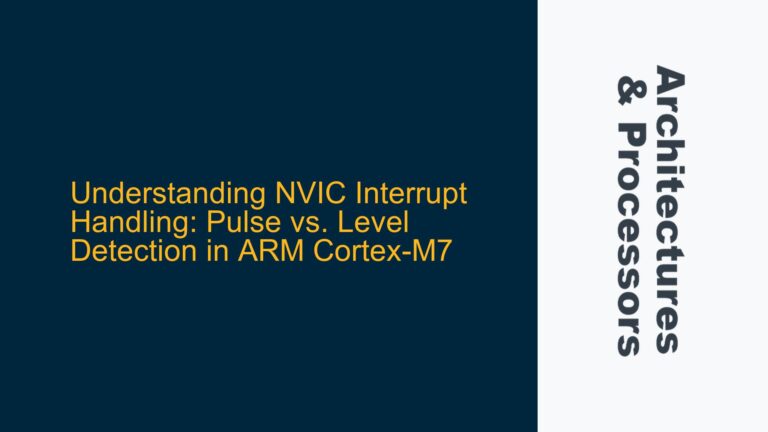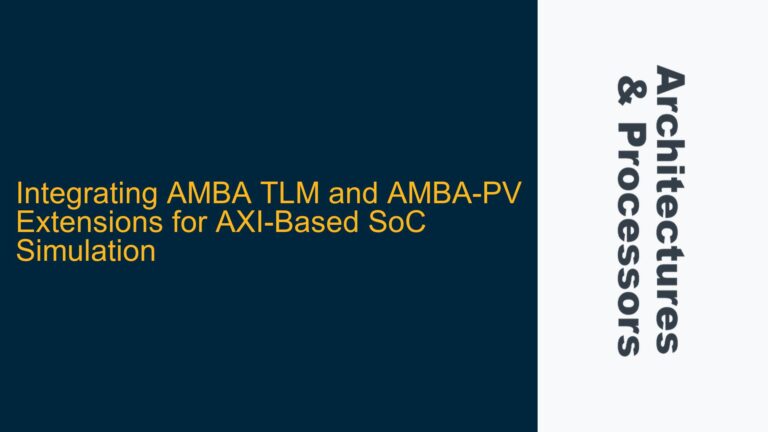ARM-Based SoC FPGA to ASIC Migration Feasibility
The transition from an ARM-based System-on-Chip (SoC) FPGA design to an Application-Specific Integrated Circuit (ASIC) is a complex but achievable process. This migration involves several critical considerations, including intellectual property (IP) licensing, design reusability, and verification strategies. The primary challenge lies in the fact that SoC FPGAs often incorporate hard ARM processor cores, which are tightly integrated with FPGA fabric. When moving to an ASIC, the ARM processor core must be licensed directly from ARM, and the FPGA fabric must be replaced with custom logic or standard cell libraries. This process requires a deep understanding of ARM’s AMBA protocols, IP integration, and the nuances of ASIC design flows.
The feasibility of this transition depends on several factors, including the complexity of the original FPGA design, the availability of equivalent ARM IP for ASIC implementation, and the ability to re-express FPGA-specific constructs in ASIC-compatible RTL. Additionally, the verification strategy must be adapted to account for the differences in timing, power, and performance between FPGA and ASIC implementations. This section will explore the key challenges and considerations involved in migrating an ARM-based SoC FPGA design to an ASIC.
Licensing ARM IP and FPGA Fabric Replacement
One of the most significant challenges in transitioning from an SoC FPGA to an ASIC is the licensing of ARM IP. In an SoC FPGA, the ARM processor core is typically provided as a hard macro, pre-integrated with the FPGA fabric. When moving to an ASIC, the ARM core must be licensed directly from ARM, and the FPGA fabric must be replaced with custom logic or standard cell libraries. This requires a thorough understanding of ARM’s licensing models, including the availability of the specific ARM core used in the FPGA design and any associated peripherals or interconnect IP.
The replacement of FPGA fabric with ASIC-compatible logic is another critical consideration. FPGA fabric is highly configurable and often includes features such as DSP blocks, block RAM, and high-speed transceivers that are not directly available in standard ASIC libraries. These features must be re-implemented using ASIC-compatible RTL, which can be a complex and time-consuming process. Additionally, the timing and power characteristics of the FPGA fabric may differ significantly from those of the ASIC implementation, requiring careful analysis and optimization.
The integration of the ARM core with the ASIC logic also presents challenges. In an SoC FPGA, the ARM core is typically connected to the FPGA fabric via a high-speed interconnect such as AXI or AHB. In an ASIC, this interconnect must be re-implemented using standard cell libraries, and the timing and performance characteristics must be carefully verified. This requires a deep understanding of ARM’s AMBA protocols and the ability to optimize the interconnect for the specific requirements of the ASIC design.
Verification and Timing Closure in ASIC Migration
The verification strategy for an ASIC implementation of an ARM-based SoC FPGA design must be adapted to account for the differences in timing, power, and performance between FPGA and ASIC implementations. In an FPGA, timing closure is typically achieved using the FPGA vendor’s tools, which are optimized for the specific architecture of the FPGA fabric. In an ASIC, timing closure must be achieved using standard cell libraries and ASIC design tools, which may require significant effort and expertise.
One of the key challenges in ASIC verification is ensuring that the timing constraints and performance requirements of the original FPGA design are met in the ASIC implementation. This requires a thorough understanding of the timing characteristics of the ASIC libraries and the ability to optimize the design for the specific requirements of the ASIC process technology. Additionally, the power characteristics of the ASIC implementation may differ significantly from those of the FPGA, requiring careful analysis and optimization.
The verification of the ARM core and its integration with the ASIC logic is another critical consideration. In an SoC FPGA, the ARM core is typically pre-verified by the FPGA vendor, and the focus of verification is on the integration of the core with the FPGA fabric. In an ASIC, the ARM core must be verified in the context of the ASIC design, including the timing and performance of the interconnect and any custom logic. This requires a comprehensive verification strategy, including the use of simulation, formal verification, and hardware emulation.
The migration from an ARM-based SoC FPGA design to an ASIC also presents challenges in terms of design reusability. In an FPGA, the design is typically expressed in RTL that is optimized for the specific architecture of the FPGA fabric. In an ASIC, the RTL must be re-expressed in a form that is compatible with standard cell libraries and ASIC design tools. This may require significant modifications to the original RTL, including the removal of FPGA-specific constructs and the addition of ASIC-specific optimizations.
Implementing Data Synchronization Barriers and Cache Management
One of the key challenges in migrating an ARM-based SoC FPGA design to an ASIC is ensuring proper data synchronization and cache management. In an FPGA, the ARM core and the FPGA fabric typically operate in separate clock domains, and data synchronization is achieved using FPGA-specific constructs such as dual-port RAM or FIFOs. In an ASIC, these constructs must be re-implemented using standard cell libraries, and the timing and performance characteristics must be carefully verified.
Data synchronization barriers are critical in ensuring that data is properly synchronized between the ARM core and the ASIC logic. In an FPGA, these barriers are typically implemented using FPGA-specific constructs, but in an ASIC, they must be implemented using standard cell libraries. This requires a deep understanding of the timing characteristics of the ASIC libraries and the ability to optimize the design for the specific requirements of the ASIC process technology.
Cache management is another critical consideration in the migration from an FPGA to an ASIC. In an FPGA, the cache is typically implemented using FPGA-specific constructs, but in an ASIC, it must be implemented using standard cell libraries. This requires a thorough understanding of the cache architecture and the ability to optimize the design for the specific requirements of the ASIC process technology. Additionally, the timing and power characteristics of the cache may differ significantly between the FPGA and ASIC implementations, requiring careful analysis and optimization.
The verification of data synchronization and cache management in an ASIC implementation is also a critical consideration. In an FPGA, these aspects are typically pre-verified by the FPGA vendor, but in an ASIC, they must be verified in the context of the ASIC design. This requires a comprehensive verification strategy, including the use of simulation, formal verification, and hardware emulation.
Optimizing Bus Fabric Configurations for Performance
The optimization of the bus fabric configuration is another key challenge in migrating an ARM-based SoC FPGA design to an ASIC. In an FPGA, the bus fabric is typically implemented using FPGA-specific constructs, but in an ASIC, it must be implemented using standard cell libraries. This requires a deep understanding of the AMBA protocols and the ability to optimize the bus fabric for the specific requirements of the ASIC design.
The performance of the bus fabric in an ASIC implementation may differ significantly from that in an FPGA, requiring careful analysis and optimization. This includes optimizing the arbitration logic, the data path, and the control signals to ensure that the bus fabric meets the performance requirements of the ASIC design. Additionally, the timing and power characteristics of the bus fabric may differ significantly between the FPGA and ASIC implementations, requiring careful analysis and optimization.
The verification of the bus fabric in an ASIC implementation is also a critical consideration. In an FPGA, the bus fabric is typically pre-verified by the FPGA vendor, but in an ASIC, it must be verified in the context of the ASIC design. This requires a comprehensive verification strategy, including the use of simulation, formal verification, and hardware emulation.
Resolving DFT and Power Domain Challenges
The migration from an ARM-based SoC FPGA design to an ASIC also presents challenges in terms of Design-for-Test (DFT) and power domain management. In an FPGA, DFT is typically handled by the FPGA vendor’s tools, but in an ASIC, it must be implemented using standard cell libraries and ASIC design tools. This requires a thorough understanding of DFT techniques and the ability to optimize the design for the specific requirements of the ASIC process technology.
Power domain management is another critical consideration in the migration from an FPGA to an ASIC. In an FPGA, power domains are typically managed using FPGA-specific constructs, but in an ASIC, they must be implemented using standard cell libraries. This requires a deep understanding of power domain architecture and the ability to optimize the design for the specific requirements of the ASIC process technology. Additionally, the timing and power characteristics of the power domains may differ significantly between the FPGA and ASIC implementations, requiring careful analysis and optimization.
The verification of DFT and power domain management in an ASIC implementation is also a critical consideration. In an FPGA, these aspects are typically pre-verified by the FPGA vendor, but in an ASIC, they must be verified in the context of the ASIC design. This requires a comprehensive verification strategy, including the use of simulation, formal verification, and hardware emulation.
Conclusion
The transition from an ARM-based SoC FPGA design to an ASIC is a complex but achievable process that requires a deep understanding of ARM IP licensing, design reusability, and verification strategies. The key challenges include the licensing of ARM IP, the replacement of FPGA fabric with ASIC-compatible logic, and the adaptation of the verification strategy to account for the differences in timing, power, and performance between FPGA and ASIC implementations. By carefully addressing these challenges and leveraging a comprehensive verification strategy, it is possible to successfully migrate an ARM-based SoC FPGA design to an ASIC.






